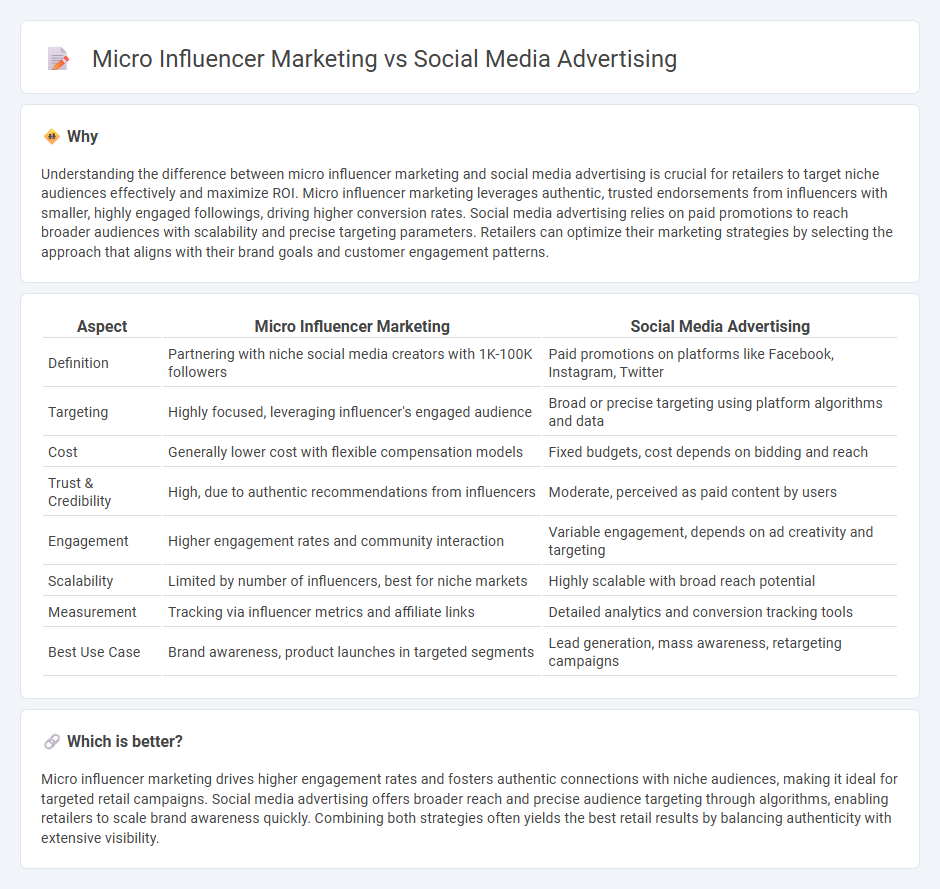
Micro influencer marketing leverages niche audience trust through authentic content creation, resulting in higher engagement rates and targeted reach compared to broad social media advertising campaigns. Social media advertising offers scalable exposure and precise demographic targeting but often faces ad fatigue and lower user trust. Explore how combining these strategies can maximize retail brand impact and ROI.
Why it is important
Understanding the difference between micro influencer marketing and social media advertising is crucial for retailers to target niche audiences effectively and maximize ROI. Micro influencer marketing leverages authentic, trusted endorsements from influencers with smaller, highly engaged followings, driving higher conversion rates. Social media advertising relies on paid promotions to reach broader audiences with scalability and precise targeting parameters. Retailers can optimize their marketing strategies by selecting the approach that aligns with their brand goals and customer engagement patterns.
Comparison Table
| Aspect | Micro Influencer Marketing | Social Media Advertising |
|---|---|---|
| Definition | Partnering with niche social media creators with 1K-100K followers | Paid promotions on platforms like Facebook, Instagram, Twitter |
| Targeting | Highly focused, leveraging influencer's engaged audience | Broad or precise targeting using platform algorithms and data |
| Cost | Generally lower cost with flexible compensation models | Fixed budgets, cost depends on bidding and reach |
| Trust & Credibility | High, due to authentic recommendations from influencers | Moderate, perceived as paid content by users |
| Engagement | Higher engagement rates and community interaction | Variable engagement, depends on ad creativity and targeting |
| Scalability | Limited by number of influencers, best for niche markets | Highly scalable with broad reach potential |
| Measurement | Tracking via influencer metrics and affiliate links | Detailed analytics and conversion tracking tools |
| Best Use Case | Brand awareness, product launches in targeted segments | Lead generation, mass awareness, retargeting campaigns |
Which is better?
Micro influencer marketing drives higher engagement rates and fosters authentic connections with niche audiences, making it ideal for targeted retail campaigns. Social media advertising offers broader reach and precise audience targeting through algorithms, enabling retailers to scale brand awareness quickly. Combining both strategies often yields the best retail results by balancing authenticity with extensive visibility.
Connection
Micro influencer marketing leverages individuals with niche, engaged audiences on platforms like Instagram and TikTok, amplifying authentic brand messages within retail sectors. Social media advertising complements this by targeting similar demographics using paid ads, boosting visibility and conversion rates through data-driven algorithms. Together, they create a synergistic effect, enhancing customer trust and driving retail sales growth.
Key Terms
Audience Reach
Social media advertising typically boasts a broader audience reach, leveraging platforms like Facebook, Instagram, and Twitter to target millions based on demographics, interests, and behaviors. Micro influencer marketing, however, hones in on niche audiences with higher engagement rates and trust within specific communities, often resulting in more authentic and impactful connections. Explore how each strategy can maximize your brand's visibility and engagement by learning more about their unique audience reach dynamics.
Engagement Rate
Social media advertising often delivers broad reach with an average engagement rate around 0.5% to 1%, while micro influencer marketing typically achieves higher engagement rates ranging from 3% to 8%, driven by authentic connections and niche audiences. Brands leveraging micro influencers benefit from more targeted engagement, increasing the likelihood of conversions and customer loyalty. Explore detailed analyses and case studies to understand which strategy maximizes your brand's engagement goals.
Cost Efficiency
Social media advertising often requires significant budgets for broad reach and targeting options, while micro influencer marketing leverages niche audiences at a fraction of the cost, offering higher engagement rates and authentic connections. Businesses targeting specific demographics benefit from micro influencers due to their ability to foster trust and drive conversions with lower ad spend. Explore detailed comparisons on cost efficiency to optimize your marketing strategy.
Source and External Links
Social network advertising - Wikipedia - Social media advertising, also called social media targeting, involves using demographic, behavioral, and social data to target ads on social networking platforms, enhancing ad delivery based on users' profiles and interactions.
Social Media Advertising: Definition, Types, and Benefits | AdRoll - Social media advertising is digital marketing involving paid ads on social platforms, where advertisers select target audiences, set budgets and goals, create ads, and track campaign performance via platform ad managers.
Social media advertising: Cost, benefits, and tips for 2025 - Paid ads on platforms like Facebook, Instagram, and TikTok help brands reach specific audiences more effectively than organic posts, using various ad formats and requiring clear objectives, audience targeting, and performance monitoring.
 dowidth.com
dowidth.com